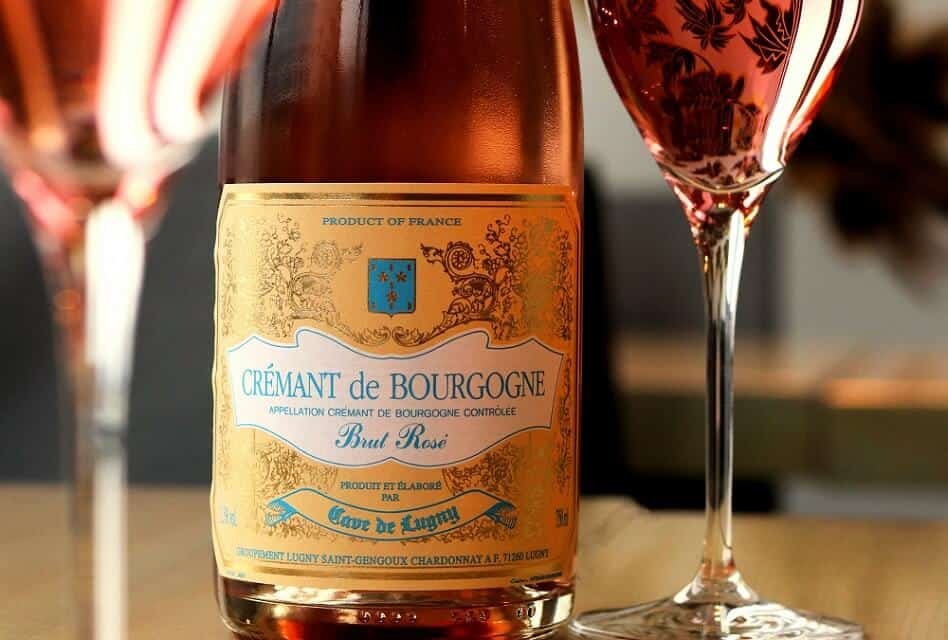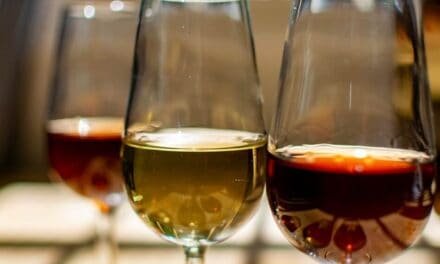Crémant is a sparkling wine from France that is either white or rosé. It can be dry or off-dry. As it undergoes a similar production process as Champagne, including bottle fermentation, it is a high-quality sparkler.
Although the wines are regulated by French wine laws, you can find a wide variety of styles made from different grapes. All of them are excellent sparkling wines.
HOW IS CRÉMANT DIFFERENT FROM CHAMPAGNE?
The main differences between Champagne and Crémant are:
- Champagne wines come from the Champagne region, while Crémant wines come from one of eight French regions outside Champagne.
- Champagne can be made from only seven varietals. Pinot Noir, Chardonnay, and Pinot Meunier grapes are the most important. Crémant vintners have more options.
- Champagne is typically more expensive.
Historically, the term Crémant was used to label semi-sparkling wines produced in the Champagne region. In contrast, wines labeled as Champagne always were full-sparkling.
Since wine laws changed in 1985, Champenoise vintners cannot use the term Crémant anymore. Nowadays, it is a protected name with AOC status, the highest quality label for French wines. Only sparklers that undergo the “Traditional Method”, which includes bottle fermentation, can carry it.
Is Crémant As Good As Champagne?
Many Crémant wines are as good as Champagne. They undergo similar production processes, and Crémant producers are as eager to make high-quality sparkling wines as Champagne vintners. Logically, they can be comparably good. Nevertheless, Crémant is usually less expensive because its reputation is not as high as Champagne’s.
HOW IS CRÉMANT DIFFERENT FROM PROSECCO?
Prosecco is another well-known sparkling wine. But the differences between Crémant and Prosecco are more significant than between Crémant and Champagne:
- Crémant wines come from France (although you might discover some exceptions). All Prosecco wines come from two regions in Italy: Friuli-Venezia Giulia and Veneto.
- While French vintners use bottle fermentation, the second fermentation phase of Prosecco takes place in steel tanks. This approach is called “the Charmat Method” or “the Italian Method”.
- Most Crémant is dry and yeasty. Prosecco tends to feature a subtle sweetness with more intense fruity and floral aromas.
HOW IS CRÉMANT DIFFERENT FROM CAVA?
Cava is a distinct type of sparkling wine, and it is high quality because it’s made with the “Traditional Method”. However, there are some differences between the two:
- As said, Crémant is from France. Cava comes from Catalonia in Spain. Most wines are produced in a subregion called Penèdes.
- The grapes that Crémant vintners may use differ based on local wine laws. For Cava, winemakers proceed primarily with four traditional Spanish varieties: Macabeu, Xarel·lo, Parellada, and Subirat.
WHERE DOES CRÉMANT COME FROM?
Winemakers in eight different French wine regions produce Crémant wines. The complete name of the sparkling wine gives away its home region. For example, Crémant d’Alsace comes from the Alsace region in the Eastern part of the country. The eight regions are:
- Alsace
- Bordeaux
- Bourgogne (Burgundy)
- Die
- Jura
- Loire
- Limoux
- Savoie
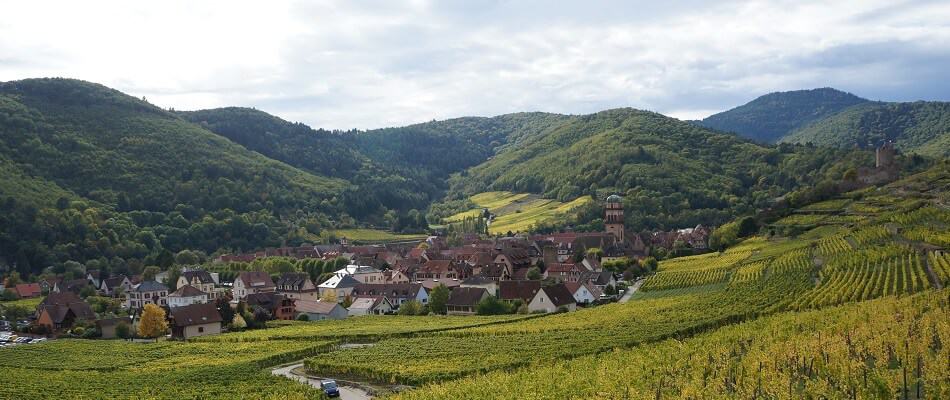
Vineyards in Keyserberg in the Alsace Region, France
WHAT IS CRÉMANT MADE FROM?
Vintners can make Crémant sparkling wines from various grapes. As they have to follow regional production rules, they are limited in their choice and have to focus on varieties that are characteristic of their home region:
- Alsace: Auxerrois, Chardonnay, Pinot Blanc, Pinot Gris, Pinot Noir, Riesling
- Bordeaux: Cabernet Franc, Cabernet Sauvignon, Carmenère, Malbec, Merlot, Muscadelle, Petit Verdot, Sauvignon Blanc, Sémillon
- Bourgogne: Aligoté, Chardonnay, Gamay, Melon de Bourgogne, Pinot Blanc, Pinot Gris, Pinot Noir, Sacy
- Die: Aligoté, Clairette, Muscat Blanc à Petits Grains
- Jura: Chardonnay, Pinot Noir, Poulsard, Savagnin, Pinot Gris, Poulsard, Trousseau
- Loire: Arbois, Cabernet Franc, Cabernet Sauvignon, Chardonnay, Chenin Blanc, Grolleau, Grolleau Gris, Pinot Noir, Pineau d’Aunis
- Limoux: Chardonnay, Chenin Blanc, Mauzac, Pinot Noir
- Savoie: Aligoté, Altesse, Chardonnay, Chasselas, Jacquère
HOW IS CRÉMANT MADE?
The production process is similar to the process of making Champagne. After harvesting and pressing the grapes, vintners let their juice ferment to produce a still base wine. Typically, this base wine is highly acidic. In most cases, it is a blend of wines from different grape varieties and sometimes even from different vineyards.
The next step in the process is the second fermentation. It takes place in bottles and is called “the Traditional Method“. The vintners fill the still base wine into bottles and add a mix of wine, sugar, and yeast to restart fermentation. Because they seal the bottles, the CO2 produced during the fermentation cannot escape. Instead, it forms the delicate bubbles that sparkling wine lovers admire.
Even after the fermentation ends and the yeast cells die, the sparkling wine ages further into the bottle. This “on the lees”-aging can take up to three years, depending on the regional production rules. During that time, the wine develops more body as well as additional aromas.
Before selling the wine, vintners have to remove the dead yeast cells. Thus, they riddle the bottles with the help of a device called “riddler”. This special bottle rack moves the bottle daily to move the yeast into the bottleneck slowly. Then, the winemakers freeze the bottleneck, including the yeast cells inside, and remove the cork. The pressure of the CO2 inside the bottle forces the frozen yeast out.
After compensating for the wine lost during the yeast removal, the sparkling wine is ready for sale.
HOW DOES CRÉMANT TASTE?
Most Crémant wines are dry, high in acidity, and light- to medium-bodied. They typically feature yeasty aromas from bottle fermentation. Depending on their home region and the local production rules, they can have quite versatile additional aromas. For example, Crémant de Loire is famous for its delicious flavors of lemon, pear, and honey.
Even within one region, styles can differ significantly. In the Northern part of the Burgundy region, you can find crisp and fresh styles, while Southern Burgundy is home to riper and bolder Crémant wines.
Rosé styles often feature the delicious aromas of red fruits such as strawberries. Besides, expect crisp acidity and subtle yeasty notes.
HOW TO SERVE CRÉMANT?
Like Champagne or other precious sparkling wines, Crémant is a perfect beverage for celebrations. Whether you are toasting an anniversary, a newlywed couple, or a successful business deal, the French sparkler is a great choice. But of course, you can also combine it with food (more details on food pairings below). In any case, you should pick the proper glassware and make sure the wine has the optimal serving temperature.
Which is the Best Glass for Crémant Wines?
The best glass to serve Crémant is a Champagne flute. This tall, slim glass helps preserve the sparkler’s bubble for as long as possible so it will not go flat. Tulip-shaped sparkling wine glasses work as well.
Which Is the Best Serving Temperature for Crémant?
When serving it, make sure that it is chilled. It’s best between 43 and 46°F (6-8°C). To bring it to this temperature, put it into your regular refrigerator or an ice bucket for about 30 minutes before opening the bottle.
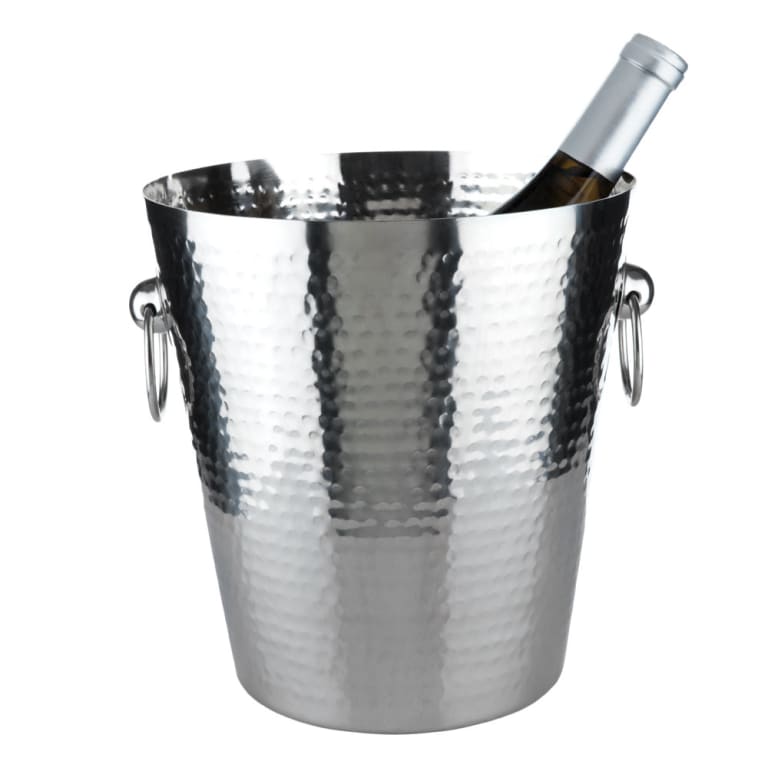
Stainless-Steel Ice Bucket
$49.99
from: Wine.com

Riedel Vinum Champagne Flutes (Set of 2)
$64.97
from: Wine.com
Should You Decant Crémant?
You should not decant Crémant wines. Like most sparkling wines, they do not benefit significantly from contact with oxygen. Furthermore, leaving them in a decanter would cause the delicate bubbles to disappear rapidly, making the wine taste flat and dull.
HOW TO STORE CRÉMANT?
Treat your Crémant bottles like you would treat any table or sparkling wine: Find a dark, cool place, preferably in your basements, for it. Shield the bottle from sunlight, vibrating devices like air conditioning, and aggressively smelling chemicals such as cleaning agents, wall paint, or heating oil.
In any case, a wine fridge is optimal for storing a good bottle of Crémant.
Can Crémant Go Bad?
Like all sparkling wines, Crémant can go bad. Especially when you expose it to heat, sunlight, or vibrations, you increase the chance it goes off. It is most likely not drinkable if it has no bubbles and tastes flat or has unpleasant vinegar-like aromas.
How Long Does Crémant Last When Open?
After opening a bottle of Crémant, you should consume it within 2 to 3 days maximum. Make sure to reseal the bottle with the original cork or a reusable bottle stopper. Then, put it into your fridge.
Can You Age Crémant Wines?
Crémant wines are not made for aging. They will not get perceivably better if you store them for years. Thus, you better consume them within one to two years of buying them.
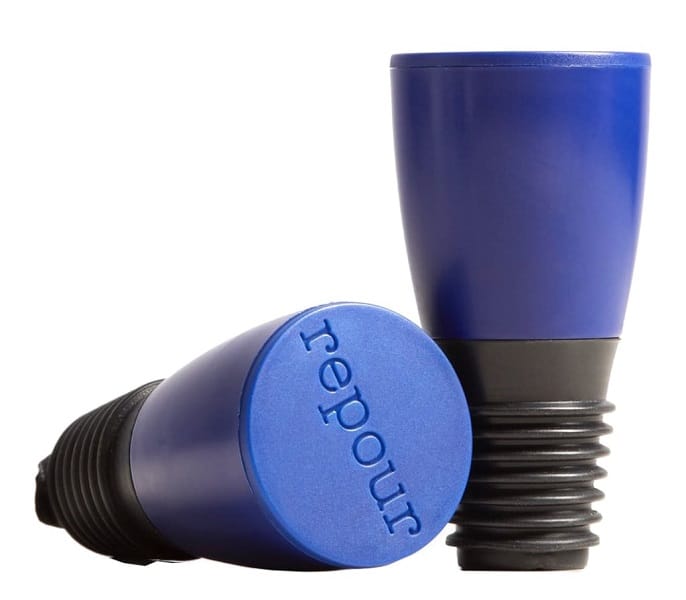
Repour Wine Saver, 10 Pack
$19.99
from: Wine.com
CRÉMANT FOOD PAIRING
Crémant wines are surprisingly food-friendly. Here are some recommendations :
- The French sparklers are delicious with many light vegetarian meals, for example, vegetable soups featuring pumpkin, squash, or eggplant. Salads with balsamic vinaigrette are good pairings, too.
- Especially wines from the Loire Valley or Limoux go very well with seafood such as grilled salmon, shrimp, lobster, or oysters.
- Wines from Burgundy or Alsace fantastically match fried dishes, including calamari, but also chicken. In particular spicy meals are proper matches because the wines’ bubbles help clean the palate and reduce the heat.
- Finally, consider combining your sparkling wine with creamy cheeses. Both cow and goat milk cheese are fine.
CRÉMANT SHOPPING TIPS
We have already discussed that Crémant is a protected label in France. So when you come across a French sparkling wine carrying it, you can be sure it is a high-quality bottle. However, be aware that some sparklers from other European countries may be labeled similarly, in particular if French is an official language there. These countries include Belgium, Luxembourg, and Switzerland.
For an entry-level French Crémant, you must pay between 15 and 25 USD per bottle of 750ml. Better styles can cost up to 40 USD. Here are some recommendations:
- type: white, sparkling
- origin: Alsace, France
- varietal: Pinot Blanc, Pinot Gris, Pinot Noir, Riesling, Auxerrois
- alcohol: 12.0%
Bailly Lapierre Crémant de Bourgogne Reserve Brut
- type: white, sparkling
- origin: Burgundy, France
- varietal: Chardonnay, Pinot Noir
- alcohol: 12.0%
Victorine De Chastenay Rose Brut Crémant De Bourgogne
- type: rosé, sparkling
- origin: Burgundy, France
- varietal: Pinot Noir
- alcohol: 12.5%
FINAL WORDS
If you are a sparkling wine lover, but Champagne scares you off because of its price tag, then Crémant is an excellent alternative for you. It is high-quality with delicate bubbles, matches many foods, and is much more affordable. So when looking for a great French sparkler, consider buying a bottle of Crémant.

